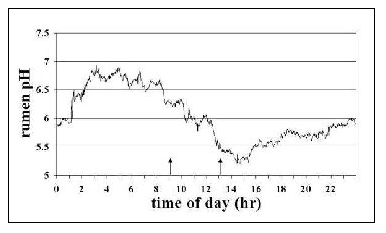Acidosis in Dairy Cows
Published: November 14, 2008
By: Manitoba Agriculture, Food and Rural Initiatives
SARA
The pH (acidity) of rumen fluid is usually between 6.0 and 6.4. Rumen pH fluctuates during the day with drops usually associated with grain consumption (Figure 1).

Source: Sub-Acute Ruminal Acidosis (SARA) in Dairy Cows. OMAF: 2003.
Dr. Karen Beauchemin of Agriculture and Agri-Food Canada defines acidosis as occurring when the rumen pH remains below 5.8 for more than 5 consecutive hours per day. Other dairy scientists state that a rumen pH of <5.5 is indicative of SARA. During normal digestion, the volatile fatty acids produced by grain breakdown are absorbed by the rumen papillae where they enter the bloodstream and are subsequently used as an energy source for milk production. The problem of SARA arises when the level of VFA in the rumen exceeds the ability of the animal to absorb the acids. They accumulate in the rumen and cause the pH to drop.
Symptoms of SARA
Decreased feed intake and erratic feed consumption patterns are the first signs of SARA in a herd. These symptoms will be easier to pick out in some herds than in others. For example, it may be difficult to pick out an affected cow in a group-fed situation. Close observation at feeding times is therefore important. Reduced feed intake will be associated with reduced cud-chewing and lower milk production. A milk fat depression may or may not occur. During bouts of SARA, fecal consistency becomes more fluid. Cows often experience laminitis. Longer term consequences of SARA include weight loss and poor body condition.
Diagnosing SARA
Determining the pH of rumen fluid is the most accurate way of diagnosing SARA. However, obtaining rumen samples with a stomach tube will give inaccurate results due to contamination with saliva and its buffers. The recommended method of collection is rumenocentesis which can easily be done by a veterinarian. The best time to sample cows is 5-8 hours after feeding, if the feeding program is a TMR fed once daily, or 2-5 hours after concentrate feeding, if forage and concentrate are fed separately. Sample at least 10 cows, within 60 DIM, per feeding group. When 25% or more of the cows have a pH less than 5.5, the group can be considered to be suffering from SARA.
Preventing SARA
1. Adapt the Rumen. The rapid introduction of fresh cows to high concentrate diets is the main
cause of SARA. The changes in the rumen microbial population and in rumen papillae necessary
to handle high grain intakes take 3-5 weeks respectively. Close-up dry cows should receive diets
with 8-10 lbs of grain by calving time.
2. Avoid Abrupt Changes. Increase grain feeding to peak amounts gradually over the first 3-4
weeks of lactation.
3. Avoid Slug Feeding. Feed no more than 6-7 lbs of a highly fermentable grain, such as barley,
per feeding. This necessitates multiple feedings of grain in a component feeding situation. The
goal of feeding management is to minimize fluctuations in rumen pH by having cows consume
numerous smaller meals per day.
4. Meet the Fibre Requirements of Cows. Ensure diets contain >20% ADF and 30% NDF.
Balance the Amount of Non-Fibre Carbohydrates. Levels of NFC exceeding 42% in the diet
predispose cows to acidosis.
5. Provide Effective Fibre. 75-80% of NDF should be from forage. Avoid over mixing TMR’s
which can lower particle size and effective NDF. Make sure particle length is sufficient to be
"effective". 8-10% of a TMR should remain on the top screen of the Penn State separator
(>19mm).
6. Minimize Sorting of Feed Ingredients. Sorting of feed ingredients can occur during mixing,
delivery and in the feed bunk. Maintain the advantage of a TMR by ensuring each mouthful is a
balanced ration. If cows are sorting out feeds, in effect, they are practicing slug feeding.
7. Feed a Buffer. Buffers such as sodium bicarbonate help to increase rumen pH.
8. Monitor Dry Matter of Wet Forages in a TMR. Changes in the dry matter content of a
silage can alter the forage:concentrate ratio. Adjustments for changing moisture content need
to be made on a regular basis.
Manitoba Agriculture, Food and Rural Initiatives
Nutrition Update (Volume 14 No. 3)
Source
Manitoba Agriculture, Food and Rural InitiativesRelated topics:
Recommend
Comment
Share
Orffa Excentials
17 de abril de 2015
Congrats for the article.
You are right, the first step to prevent rumen acidosis is nutritional management. However, once a suitable nutritional management has been established, it is really important to increase the conversion of lactic acid into propionic acid by means of lactic acid utilizers bacteria.
To achieve this, the supplementation with salts of malic acid is a great solution, since this compounds increase the capacity of Selenomonas ruminantium (lactic acid utilizer) to convert lactic acid into propionic acid. When given in forms of salts, their effects are better.
See the attached papers if this topic is of your interest:
1. https://www.academia.edu/11654102/Improving_dairy_cow_health_and_productivity_with_natural_rumen_enhancers
2. Manipulation of Rumen Fermentation with Organic Acids Supplementation
in Ruminants Raised in the Tropics (REVIEW). http://www.pjbs.org/pjnonline/fin589.pdf
3. Effect of the addition of malate on in vitro rumen fermentation
of cereal grains. https://www.GOOGLE.com.sa/url?sa=t&rct=j&q=&esrc=s&source=web&cd=1&cad=rja&uact=8&ved=0CB4QFjAA&url=http%3A%2F%2Fwww.researchgate.net%2Fprofile%2FMaria_Carro2%2Fpublication%2F10910021_Effect_of_the_addition_of_malate_on_in_vitro_rumen_fermentation_of_cereal_grains%2Flinks%2F0deec52ce4e183d5e6000000.pdf&ei=1g4xVfzBHM3KPZy7gYgB&usg=AFQjCNEh-cQ--gdcXPuvWuQ85PAMhd3BTQ
4. Mechanism of Propionate Formation by Selenomonas
ruminantium, a Rumen Micro-organism. http://mic.sgmjournals.org/content/61/1/1.full.pdf
5. Effect of dicarboxylic acids and Aspergillus oryzae fermentation extract on lactate uptake by the ruminal bacterium Selenomonas ruminantium. http://www.ncbi.nlm.nih.gov/pubmed/16348354
Regards,
Alfredo.
Recommend
Reply

Would you like to discuss another topic? Create a new post to engage with experts in the community.






